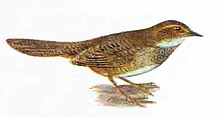Noisy scrub-bird
| Noisy scrubbird | |
|---|---|
 |
|
| Scientific classification | |
| Kingdom: | Animalia |
| Phylum: | Chordata |
| Class: | Aves |
| Order: | Passeriformes |
| Family: | Atrichornithidae |
| Genus: | Atrichornis |
| Species: | A. clamosus |
| Binomial name | |
|
Atrichornis clamosus (Gould, 1844) |
|
The noisy scrubbird (Atrichornis clamosus) is a species of bird in the Atrichornithidae family. It is endemic to the coastal heaths of south-western Australia (east of Albany). The Noisy Scrubbird features a dark brown colored back, rust-like colored wings and a speckled chestnut colored breast region with a grey-brown or pink bill and brown or silver legs and feet. They vary from 19–23 cm. in length and 25-58 grams. The males are distinguished from the females by exhibiting a black triangle on their throat. They are closely related to the Lyrebird, having only evolutionarily distinguished from them approximately 30-35 million years ago. They prefer feeding upon small invertebrates such as ants, beetles and in the extremely dense understory and vegetative cover that only occurs after environmental damages.
The noisy scrubbird is one of Australia's rarest birds. It was presumed extinct until a population was discovered at Two Peoples Bay, east of Albany in Western Australia in the 1960s. Since then a recovery plan has been put into action. Populations of the bird have been translocated to nearby Bald Island, in Waychinicup National Park, as well as the Porongorup Ranges, where a bushfire had destroyed much of the population.
A reason the noisy scrubbirds populations are so threatened are due to them being a very endemic species with specific living conditions and niche. They prefer subtropical to temperate rainforests >600 m in elevation with closed forests that are within 5–15 meters in height. They require dense ground cover wetlands with cover that only occurs in their small range after the recovery from a forest fire or other serious natural disaster such as flooding or logging events. In addition, they also require very dense leaf litter to feed upon the leaf degrading invertebrates in which they prefer. They typically inhabit recovering areas after they have been recovering for approximately 10 years, but there has been reported colonizations in as soon as 2 years following the damage. The scrubbird has never been recorded to inhabit an area that has not been burnt or damaged in the previous 50 years. There known range is approximately 45 cubic km combined including the Two Peoples Bay and Bald Island populations.
...
Wikipedia

